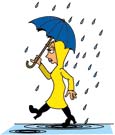Get to know H2O!

![]()
Get to know H2O!

![]()
This lesson is divided into two parts, one dealing with correlating temperature and the other correlating density.
Part I
Goals:
To explain the transitions from one state to another.
To observe temperature changes and correlate the three physical states to temperature.
To associate visual observations with temperature changes.
To graph a plot of temperature vs. time.
Content Areas:
Math - temperature measurement
Language Arts - journal writing, lab report
Ice
500 mL beakers
Hot plate(s)
Thermometers
Graph paper
Procedure: (1 hour)
2) Discuss transitions between the three physical states of water. Lead to discussion of evaporation, condensation, sublimation, crystallization, and melting. Can you associate weather with all of these? Examples of these?
3) Break students into groups. Explain graphing techniques.
4) Have students keep a journal of observations during their experiment. Question why observations are important to scientific studies.
5) Have each group perform the three following experiments:
b. Fill a beaker half full of tap water, then fill the rest of the beaker with ice. Again, record temperature observations every 3 minutes for 15 minutes. Record observations. What happens to the ice?
c. Fill a beaker half full of tap water, then place the beaker on a hot plate.
CAUTION: The hot plate is very hot when operating! DO NOT LET THE BEAKER BOIL DRY! Record temperature observations every three minutes for 15 minutes. Record visual observations. What happens to the water? What do you observe on the sides of the beaker?
6) Plot temperature vs. time on graph paper for each experiment. Time should be on the x-axis. As a class, compare the three graphs. What visual observations were made? What happened to the temperature when ice was added? Why does the temperature stay constant? What would eventually happen to the temperature after the ice melted? What happened to the temperature graph when boiling occurred? Why does the temperature remain constant? (equilibrium of two phases)
Goals:
To record observations of experiments and use this information to write a laboratory report discussing what they have learned.
Content Areas:
Language Arts - lab report
Materials:
Salt water solution
Eggs
500 mL beakers
Scale
Procedure: (1 hour)
2) Inform students they must record all observations and questions for a lab report due the following day. The initial inquiry will be: Why do things float better in salt water than in fresh water? Every time a question or observation arises, or a procedure is conducted in the experiment, it must be recorded in the lab report. An official lab format is not necessary.
3) Fresh Water
b) Taste it.
c) Now put a raw egg into the glass.
d) What happens to the egg?
4) Salt Water
b) Taste it.
c) How does it taste different from fresh water? How does it look different from fresh water?
d) Now put a raw egg into the beaker.
e) What happens? It floats! Why?
5) Discuss why the salt water mixture weighs more than the fresh water mixture.
Why does the egg float in the salt water mixture? Describe how density of
salt water makes it easier to float.
6) Discuss the Great Salt Lake and the Dead Sea. Would it be easier, harder, or equally as challenging to learn to swim in these bodies of water as compared to one of the Great Lakes?
* Experiment courtesy of Bill Ney the Science Guy, a Walt Disney Production.
Assessment:
Extensions:
Making Waves - written by Jennifer Cannistra, Jamie Hanna, Michael LeRoy, & Kim Mongoven
This page was submitted by St. Norbert College Ocean Voyagers Program